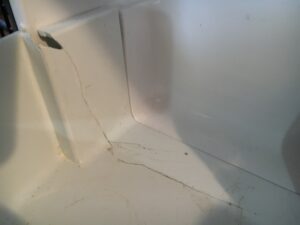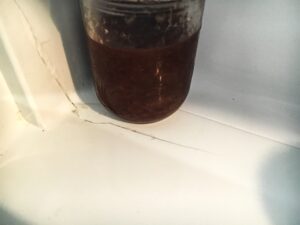Mister Glue, Fillers and Household Repairs
One of the wonderful things about Mister Glue is its simplicity of use. Epoxies on the other hand can be a pain to use. They can be very messy. A small drop of Mister Glue applied to a loose piece of household furniture will fix it in a jiffy.
But if you are trying to fix that old rocking chair with the loose spindle, stretcher or leg and there is a gap, you will be tempted to take it apart, make a mess in the house by getting epoxy all over the place and trying to fix parts that really don’t need fixing. Epoxy will fill the gaps but you can end up doing a lot more work than necessary.
That’s where Mister Glue can be used with a filler. You don’t have to remove the loose spindles even if there is a small gap.
Various sorts of materials can be used as fillers with Mister Glue. Sawdust with wood gaps; baking soda with a hole or crack in for the PVC pipe under the sink in the house or RV.
Mister Glue will work with almost any material: sawdust, course or fine, baking soda or even coffee. I’ve used coffee to get a good colour match. I’ve not tried them, but I imagine that you could use powdered paints to get a perfect match on that cracked vase in the living room.
As I have mentioned, Mister Glue is an amazingly fast and strong glue. But you need the pieces to fit closely together. Again, the better the fit the better the bond.
Occasionally, something like epoxy will be better as you have more working time. Mister Glue is very fast. I always suggest that one practice putting the pieces together before applying the glue. The less sliding around you have to do, again, the better the bond. But, what do you do if you are left with a gap or holes after you have bonded the pieces of your project together? This can happen because small chips have gone missing or with some plastics, bending is inevitable.
One you have put your project together, you can use the baking powder or sawdust or whatever else you choose, to fill the gap. Place the powder or baking soda into the space that needs filling. Add several drops of Mister Glue. Enough so that it soaks all the way in. It will go quite hard in one or two seconds. If the space that you are filling is a bit larger or deeper, like a screw hole that you are rebuilding, then you may need to build it up gradually. Once properly set, you will be able to scrape or sand smooth. It will not stain, in the case of sawdust with wood repair, but you can paint over it.
If you are concerned about colour, you may want to take a piece of wood or something put some of the powdered material that you are using and put a few pinches of it on that surface. A quarter or half a teaspoon would be plenty. And a few drops of glue. You should really start with one drop to get the idea of how deeply it will or won’t go. See how quick it is and if, for this material that you are using for a filler, does it alter the colour in any way? It many lighten up a little when dry but not always.
 For plastics, we used baking soda. This was a shelf in a refrigerator that was broken when we moved into our new house. Being difficult to replace and rather expensive when I did find it, I decided to try to repair with Mister Glue. I also was very interested in how this would work. There were several spots missing(holes) once the crack was glued back together. I didn't want all of my home made condiments(the mango chutney is great!) falling on the floor at some inopportune moment, so I added some baking soda and glue for a little extra insurance.
For plastics, we used baking soda. This was a shelf in a refrigerator that was broken when we moved into our new house. Being difficult to replace and rather expensive when I did find it, I decided to try to repair with Mister Glue. I also was very interested in how this would work. There were several spots missing(holes) once the crack was glued back together. I didn't want all of my home made condiments(the mango chutney is great!) falling on the floor at some inopportune moment, so I added some baking soda and glue for a little extra insurance.
In this particular case I was a lot less concerned about how it looked than how it held. For both the survival of my jams and chutneys and so I could show y’all how the fillers work with the glue! The spot where the shelf is cannot be seen anyway, unless you get down on the floor and look up at it.
could show y’all how the fillers work with the glue! The spot where the shelf is cannot be seen anyway, unless you get down on the floor and look up at it.
As of this writing, the shelf has been functioning quite well(and believe me, I am not careful with it - it takes a beating!) for about 3 months or so. I do check it now and again and there is no deterioration at all in the glued joint.
Household Solutions: Experimenting
If you are in the shop or have a workspace in the house and want to experiment, take some various coloured powders from around the household or shop and put a few pinches on a piece of wood or plastic. Add a drop or two of Mister Glue(or enough so that it soaks the entire bit of powder) and see how the colour comes up and how it sets. If you start with one drop, you will see how deep into the powder it goes. It will harden up pretty fast, so then try a couple of drops with the same volume of powder to see that it will go deeper. This will help in judging how much powder and glue to use when you are fixing that wobbly rocking chair.
To get a nice match on materials, we have taken a piece of what we are trying to repair, ground it up and used that for a filler to get a better match on colour and sometimes more importantly, texture. We have used this technique for plastics and granite for example.
I always suggest that you experiment first before you finalize. Make sure that the filler that you have created will set properly and colour and texture are what you want.
The applications you can use for fixing stuff around the household are endless.
And don’t forget crafts!! There again uses are endless!
#misterglue